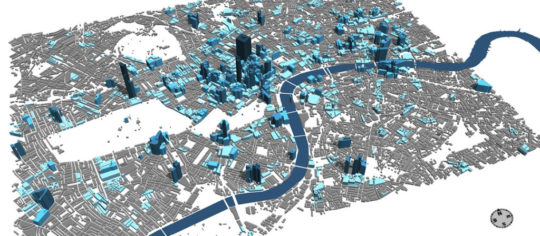 NEWS
NEWS
Tweet City: what if London’s buildings grew according to the amount of data they generated? Hügel and Roumpani’s cool visualisation tool

Stephan Hügel and Flora Roumpani, Twitter data linked to building footprints.
What if London’s buildings grew according to the amount of data they generate? Stephan Hügel (@urschrei) and Flora Roumpani (@en_topia) two PhD students from The Bartlett Centre for Advanced Spatial Analysis, University College London, have been working on a system to read in Twitter data to CityEngine and link the geo locations to building outlines.
‘As part of our time here in CASA UCL, Stephan Hugel and I, developed a simple tool to capture and visualize live tweet feeds and project them onto the actual form of the built environment’, writes Roumpani in her blog, En-topia. ‘The application uses the Twitter API, and visualizes results in 3D, similarly to the London Twitter map by UrbanTick, developed using the data collector created by Steven Gray, in an attempt to create a new urban landscape. This work, though, is a first attempt to bring real-time data feeds directly into 3D GIS and 3D cities and visualize them using a different view. As Stephan wrote: What if London’s buildings grew according to the amount of data they generate?. There is currently a big emphasis on BIM and data management, with a clear focus on sustainability and social infrastructure. However, there is very little information on how and if this process affects the way the built environment grows and evolves.’
Their project does not aim to address such questions, but ‘to demonstrate new ways of augmenting already existing spatial data. The application was built entirely in ESRI CityEngine, as it offers a range of 3D visualization techniques which relate to the urban environment. CityEngine allows the generation of forms using simple ‘rules’. In this case, the project collects real-time tweet feeds, aggregates them by a custom discrete zone system and by default, visualizes them as building heights. CityEngine provides the key-advantage of allowing the automatic storing of spatially geolocated data directly on a shapefile, augmenting GIS with live information and update the visualization real-time. That is why this application, can work with different basemaps, such as a land use map, wards, or even roads.’
At the moment, the script stores the number of total tweets for any discrete zone and keeps track of time and date. For example, if the user wants to know how many tweets will fall in the area of Hyde Park for a specific period of time, he will only have to import an outline of the park in the scene of CityEngine and adjust the values appropriately. The rules that generate geometry are also independent of the Information System, a feature which according to my opinion is one of the main advantages of CityEngine, as is allows the customization of different visualizations.
Their video is the first step in an approach to visualising an urban landscape using the objects that already exist in it; instead of abstract swirling points, bars, and artefacts hovering in the sky, the buildings themselves become the medium by which the data generated in and around them are made visible. To download the source code: http://urschrei.github.io/CityEngine.